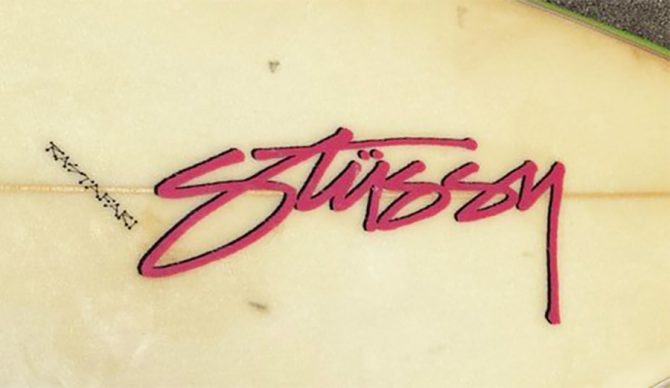Our Terms & Conditions | Our Privacy Policy
Is Stüssy Surfing’s Only Truly Iconic Brand?
Earlier in the summer I walked through the tight streets of London’s Soho. My passage was blocked by a long queue of “youths” snaking for hundreds of meters past the shops, pubs, speakeasys, theaters and clubs.
The pavement was awash with baggy jeans, the air thick with Givenchy scent and cell phone transmission all soundtracked by TikTok. Crossing the street to avoid the youths, it became apparent the head of the snake was the Stüssy shop. The security staff informed the queue wait hadn’t dropped below three hours since the store had opened at 10.00 a.m. And that was an everyday occurrence. The week before hundreds of punters, some who had traveled from China, Japan, New York and Argentina, had camped overnight for a Levi collab that dropped at 7 a.m.
A few weeks later, my 14-year-old son would spend all his birthday money on a Stüssy hoodie. Then recently I saw my 12-year-old daughter had changed her WhatsApp profile pic to the Stüssy logo. I tried to explain how Shawn Stussy had first applied that handwritten signature graphic to his swallowtail twin fins in the early 1980s, the boards being ridden by a dedicated crew of San Clemente locals. I took the roll of her eyes as a sign she wasn’t interested.
That the logo remains such an in-demand, and “cool” streetwear brand all these years later easily makes it one of surfing’s most iconic companies. While the privately owned Stüssy declines to share its revenues, the data service insight business Growjo placed its total revenue at an estimated $93.8 million annually. The revenue is one important index of its worth (and a new 5,550-square-foot flagship store opening in New York won’t hurt in that regard) but its place in youth culture and ability to shape street fashion trends is the platform behind the value.
Now surfing-based brands have had a wider cultural impact over time. In the 1980s and 1990s, big brands like Quiksilver, Gotcha and Billabong, and then Roxy, broke free of their surfing base and went global. More recently, Patagonia, and its rejection of fast fashion by creating high-quality, long-lasting products, earned billions in revenue and moved the dial in the huge outdoor market.
But none of those companies were ever truly setting fashion trends, and with the surf brands a combination of greed, expansion, brand dilution and the globalization of fast fashion, their influence declined, even in the relatively tiny surf market.
Stüssy’s reach went in the other direction. Its recent uptick in global appeal hasn’t come at the expense of its essence of cool. Shaun Stüssy is on record as saying that it was a trade show in the early ’80s that changed his approach. While he only received half a dozen orders of his high-performance surfboards, it was his tees, and the unique hand-made graphic combining elements from reggae, punk and new wave music, that flew out the door.

Remember that logo? Photo: Shredsledz
In 1984, he partnered with the accountant Frank Sinatra Jr. (not related to the singer) on a new apparel line using the Stüssy name. By 1990, the brand was generating $17 million in annual turnover and had fixed itself as a cultural barometer in the fashion and musical hubs of New York and London. Its key then, as it is now, was its ability to direct and align with the tastes and preferences of young people. It was as popular in high schools and college campuses as it was with tastemakers – mostly made up of like-minded DJs, club kids, skaters, surfers and creatives who swore allegiance to the brand. In 1991, along with James Jebbia, the then-owner of Union and future founder of streetwear label Supreme, Stüssy opened its first flagship store in New York.
Five years later, Shawn sold his stake in the company and ceased his involvement in the brand. He cited that the decision to go back to shaping, surfing and to be on hand to raise his three sons in Kauai, was the most difficult, and best, decision he’s made.
And yet 20 years on, his signature is all over kids’ hoodies from Compton to Chelsea, on dads dropping into the Venice Bowl, or DJ’s lighting up sets in Tokyo and Ibiza. Many, like my daughter, don’t know, or could care even less, that the brand’s origins started with a handwritten signature on hand-shaped surfboards ridden at Trestles. But it’s worth remembering.
Images are for reference only.Images and contents gathered automatic from google or 3rd party sources.All rights on the images and contents are with their legal original owners.


Comments are closed.